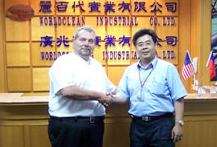
Curated with aloha by
Ted Mooney, P.E. RET

The authoritative public forum
for Metal Finishing 1989-2025

-----
Forgings suffer severe color variations during dichromate seal
I am a manufacturing engineer that thru downsizing at my company has inherited our anodize process line. This is a new line approx. 2 years old. My question involves Type II class I anodizing per MIL-A-8625. We produce machined aluminum parts for the aircraft industry form forgings primarily. The problem is a color variation of the parts from the same forging heat lot, which seems to eliminate material variation being the problem. We seal using sodium dichromate for 10 mins at 195-205F. The color variation is somewhat random from dark green to gray in appearance. The anodize always measures uniform thickness and passes the "no conductivity" test, so we are getting adequate anodic coat. This has always been present, even before the new line, it just seems to be more prevalent now. Is this a possible seal problem, or just aesthetics. Any suggestions?
Charles E. Bostaph JrMFG ENGINEER - Akron, OHIO, U.S.A
2003
From past experience and due to the statement "we inherited" I'd bet my standard cup of coffee and donut your thickness varies considerable (up to 20%). This could be caused by a number of factors not the least of which is temperature. If your are positive that every part is within 5% of what you are shooting for, than other factors must be considered such as sealing. But before you go blaming alloy or sealing make sure you tighten up your parameters (Temp/Time/Amps/Chemistry/Rectification) to broaden your window of acceptable work.This is what experts are pushing, for today's anodizer

Drew Nosti, CEF
Anodize USA
Ladson, South Carolina

2003
Thanks for the comments Drew. The thickness of the anodize does vary somewhat from part to part but is well within the mil spec of .00007 - .0010. The color versus the thickness shows no correlation. What I mean by that is some "light" parts have thicker anodize, and some "light" parts have thinner anodize, but again well within thickness spec. The anodize tank is controlled at 10 mins at 21 volts at 68-72 degrees for the group of alloys in question. Would the variation in anodize thickness allowed by the mil spec allow for such a color variation from the sealing operation. I can say from observation that the amperage varies somewhat during the 10 min cycle, but I thought that was normal as the anodize builds up on the parts. As far as the chemistry goes, we have a chemist that monitors the tanks and keeps them within spec.
Charles E. Bostaph Jr- Akron, Ohio, U.S.A
2003
Forging has "work hardened" different areas of the part so that the pore structure of the anodizing varies according to the whomping action of the forging onto the part. Thick areas will vary from thin areas, and hardest struck areas will vary from less harder hit areas - all leading to different pore structures from area to area and then different absorption of the dichromate.

Robert H Probert
Robert H Probert Technical Services
Garner, North Carolina

2003
Q, A, or Comment on THIS thread -or- Start a NEW Thread